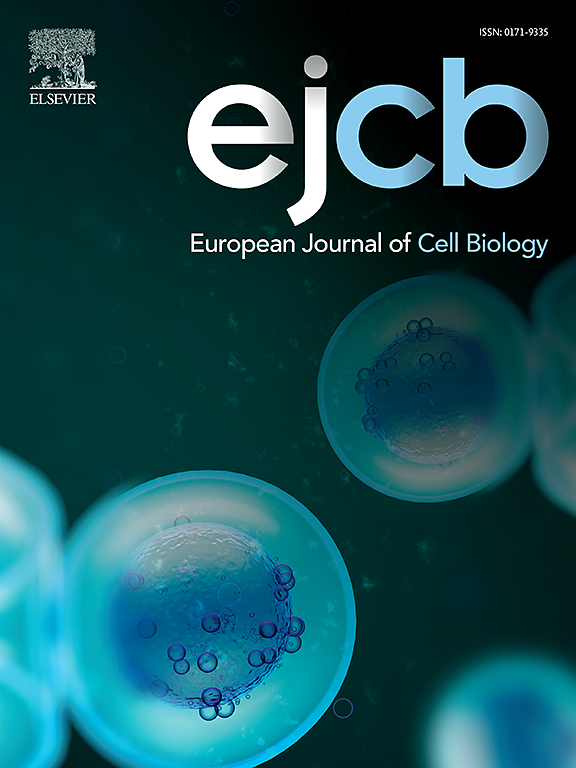The Kelch 3 motif on gigaxonin mediates the interaction with NUDCD3 and regulates vimentin filament morphology
IF 4.3
3区 生物学
Q2 CELL BIOLOGY
引用次数: 0
Abstract
Gigaxonin is an intermediate filament (IF)-interacting partner belonging to the Kelch-like (KLHL) protein family. Gigaxonin is encoded by the KLHL16 gene, which is mutated in Giant Axonal Neuropathy (GAN). The lack of functional gigaxonin in GAN patient cells impairs IF proteostasis by affecting IF protein degradation and transport. This leads to focal abnormal accumulations of IFs and compromised cellular function, with neurons being most severely impacted. We hypothesized that gigaxonin forms molecular interactions via specific sequence motifs to regulate IF proteostasis. The goal of this study was to examine how distinct Kelch motifs on gigaxonin regulate IF protein degradation and filament morphology. We analyzed vimentin IFs in HEK293 cells overexpressing wild type (WT) gigaxonin, or gigaxonin lacking each of the six individual Kelch motifs, K1-K6. All six gigaxonin deletion mutants (ΔK1-ΔK6) promoted the degradation of soluble vimentin. Compared to WT-gigaxonin, ΔK3-gigaxonin exhibited increased soluble vimentin degradation and increased presence of thick bundles of vimentin IFs. The ΔK4 mutant showed similar, but milder phenotypes compared to ΔK3. Using mass spectrometry proteomics we found that, relative to WT gigaxonin, ΔK3 gigaxonin had increased associations with ubiquitination-associated and mitochondrial proteins but lost the association with the NudC domain-containing protein 3 (NUDCD3), a molecular chaperone enriched in the nervous system. AlphaFold modeling revealed loss of gigaxonin-NUDCD3 binding with ΔK3 and altered binding with ΔK4. Collectively, our cell biological data show the induction of an abnormal GAN-like IF phenotype in cells expressing ΔK3- and, to a lesser extent, ΔK4-gigaxonin, while our proteomic profiling links the loss of gigaxonin-NUDCD3 interactions with defective IF proteostasis.
gigaxonin上的Kelch 3基序介导与NUDCD3的相互作用,并调节vimentin细丝形态
Gigaxonin是一种中间丝(IF)相互作用的伙伴,属于Kelch-like (KLHL)蛋白家族。巨轴索蛋白由KLHL16基因编码,该基因在巨轴索神经病变(GAN)中发生突变。GAN患者细胞中缺乏功能性巨胞球蛋白会通过影响IF蛋白的降解和运输而损害IF蛋白的稳态。这导致局灶性IFs异常积聚和细胞功能受损,神经元受到最严重的影响。我们假设千兆胞蛋白通过特定的序列基序形成分子相互作用来调节IF蛋白的停滞。本研究的目的是研究千兆胞蛋白上不同的Kelch基序如何调节IF蛋白降解和纤维形态。我们分析了HEK293细胞中过表达野生型(WT)千轴蛋白或缺乏六种单独Kelch基元K1-K6的千轴蛋白的波形蛋白干扰素。所有6个千兆蛋白缺失突变体(ΔK1-ΔK6)都促进了可溶性蛋白的降解。与WT-gigaxonin相比,ΔK3-gigaxonin表现出可溶性波形蛋白降解增加和厚束波形蛋白if的存在增加。与ΔK3相比,ΔK4突变体表现出相似但更温和的表型。使用质谱蛋白质组学,我们发现,相对于WT, ΔK3与泛素化相关蛋白和线粒体蛋白的关联增加,但失去了与NudC结构域蛋白3 (NUDCD3)的关联,NUDCD3是一种富集于神经系统的分子伙伴。AlphaFold模型显示gigaxonin-NUDCD3与ΔK3的结合缺失,与ΔK4的结合改变。总的来说,我们的细胞生物学数据显示,在表达ΔK3-和在较小程度上表达ΔK4-gigaxonin的细胞中,诱导了异常的gan样IF表型,而我们的蛋白质组学分析将gigaxonin-NUDCD3相互作用的丧失与IF蛋白平衡缺陷联系起来。
本文章由计算机程序翻译,如有差异,请以英文原文为准。
求助全文
约1分钟内获得全文
求助全文
来源期刊

European journal of cell biology
生物-细胞生物学
CiteScore
7.30
自引率
1.50%
发文量
80
审稿时长
38 days
期刊介绍:
The European Journal of Cell Biology, a journal of experimental cell investigation, publishes reviews, original articles and short communications on the structure, function and macromolecular organization of cells and cell components. Contributions focusing on cellular dynamics, motility and differentiation, particularly if related to cellular biochemistry, molecular biology, immunology, neurobiology, and developmental biology are encouraged. Manuscripts describing significant technical advances are also welcome. In addition, papers dealing with biomedical issues of general interest to cell biologists will be published. Contributions addressing cell biological problems in prokaryotes and plants are also welcome.
 求助内容:
求助内容: 应助结果提醒方式:
应助结果提醒方式:


